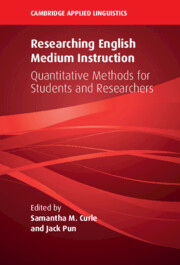Book contents
- Researching English Medium Instruction
- The Cambridge Applied Linguistics Series
- Researching English Medium Instruction
- Copyright page
- Dedication
- Contents
- Figures
- Tables
- Preface
- Acknowledgments
- Notes on Editors
- Notes on Contributors
- An Introduction to Researching English Medium Instruction Using Quantitative Research Methods
- Part I Theoretical Chapters
- Part II Empirical Chapters (Case Studies)
- 5 The Application of Partial Least Squares Structural Equation Modeling in Studies of EMI
- 6 Factor Analysis in Writing Research
- 7 Analyzing Questionnaire Data through Many-Facet Rasch Measurement: A Pilot Study of Students’ Attitudes toward EMI in the Chinese Higher Education Context
- 8 Questionnaire Development and Analysis in EMI Research
- 9 Effects of EMI on Learners’ Linguistic Development
- 10 Path Analysis of Science Learning in Hong Kong’s EMI Secondary Schools
- 11 Questionnaire Survey in Researching EMI
- 12 The Use of MANOVA in Analyzing the Effects of Gender on Perceived Difficulties in Speaking and Writing in a Hong Kong EMI University
- 13 Using a Longitudinal Quantitative Design to Investigate Student Transition from Secondary School to EMI Higher Education
- 14 A Corpus-Based Multidimensional Analysis of EMI University Classroom Discourse
- Index
- References
7 - Analyzing Questionnaire Data through Many-Facet Rasch Measurement: A Pilot Study of Students’ Attitudes toward EMI in the Chinese Higher Education Context
from Part II - Empirical Chapters (Case Studies)
Published online by Cambridge University Press: 14 December 2024
- Researching English Medium Instruction
- The Cambridge Applied Linguistics Series
- Researching English Medium Instruction
- Copyright page
- Dedication
- Contents
- Figures
- Tables
- Preface
- Acknowledgments
- Notes on Editors
- Notes on Contributors
- An Introduction to Researching English Medium Instruction Using Quantitative Research Methods
- Part I Theoretical Chapters
- Part II Empirical Chapters (Case Studies)
- 5 The Application of Partial Least Squares Structural Equation Modeling in Studies of EMI
- 6 Factor Analysis in Writing Research
- 7 Analyzing Questionnaire Data through Many-Facet Rasch Measurement: A Pilot Study of Students’ Attitudes toward EMI in the Chinese Higher Education Context
- 8 Questionnaire Development and Analysis in EMI Research
- 9 Effects of EMI on Learners’ Linguistic Development
- 10 Path Analysis of Science Learning in Hong Kong’s EMI Secondary Schools
- 11 Questionnaire Survey in Researching EMI
- 12 The Use of MANOVA in Analyzing the Effects of Gender on Perceived Difficulties in Speaking and Writing in a Hong Kong EMI University
- 13 Using a Longitudinal Quantitative Design to Investigate Student Transition from Secondary School to EMI Higher Education
- 14 A Corpus-Based Multidimensional Analysis of EMI University Classroom Discourse
- Index
- References
Summary
Questionnaires have been widely used to tap into fine-grained themes of educational studies (see also Chapters 3, 8, and 11 of the this book). Unfitted use of parametric methods, however, would result in mistakenly interpreting ordinal scales as equal intervals, or difficulties in resolving issues such as missing raw data. Rasch measurement, as one of several item response theoretic models, is strongly suggested for application prior to the conduction of parametric statistical tests (Boone, Staver, & Yale, 2014).
This chapter starts with introducing basic facts about Rasch modelling, and discusses three study cases that applied Rasch modeling for scale development and validation.
In addition, this chapter features a step-by-step analysis procedure for data collected from a questionnaire, which is administered among 102 undergraduate students enrolled in a university located in Shanghai, China. All of the students have registered for at least one course instructed in English, which is related to their major area of study. The questionnaire was adapted from the Japanese English Medium of Instruction Attitude Scale (JEMIAS) (Curle, 2018). Multi-facet Rasch Measurement (MFRM) analysis was conducted to investigate the possible influence of students’ academic major on their attitude toward EMI, as well as the functioning of individual items on the scale. Analysis results show that students’ disciplinary background has limited influence on their attitudes. Items demonstrating different logit scales, however, provide practical implications for designing EMI courses in Chinese higher education institutions.
- Type
- Chapter
- Information
- Researching English Medium InstructionQuantitative Methods for Students and Researchers, pp. 107 - 133Publisher: Cambridge University PressPrint publication year: 2024

